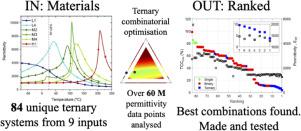Acta Materialia ( IF 8.3 ) Pub Date : 2021-01-23 , DOI: 10.1016/j.actamat.2021.116690 G. Kerridge , D.C. Sinclair , J.S. Dean

|
We demonstrate a fast, efficient combinatorial method for the optimisation of materials for multi-layer ceramic capacitors (MLCCs). Experimentally gathered permittivity-temperature profiles for nine compositions spanning a solid solution are used as input, and with series mixing rules, binary and ternary permittivity contour maps are calculated based on individual layer thicknesses. These are converted into Temperature Coefficient of Capacitance (TCC) contour maps and an algorithm is then used to identify material combinations and individual thicknesses suitable for various MLCC classifications. These facilitate targeted experimentation and allowed experimental verification of the methodology. The approach highlights that binary systems can achieve X9 (R, S T and U). classification but the addition of a third complimentary material can facilitate a tighter TCC classification (X9P) with a wider tolerance in layer thicknesses, providing a better strategy for mass production of MLCCs. The room temperature permittivity (ƐRT) for combinations with similar TCC values can also be evaluated to ensure adequate ƐRT is achieved for commercial applications.
中文翻译:

资源高效地探索三元相空间以开发多层陶瓷电容器
我们展示了一种快速,高效的组合方法,可优化多层陶瓷电容器(MLCC)的材料。实验收集了跨越固溶体的九种组合物的介电常数-温度分布图,并使用串联混合规则,根据各个层的厚度计算了二元和三元介电常数等高线图。将这些转换为电容温度系数(TCC)等高线图,然后使用一种算法来识别适合各种MLCC分类的材料组合和单个厚度。这些有助于有针对性的实验,并允许对该方法进行实验验证。该方法强调了二进制系统可以实现X9(R,ST和U)。分类,但添加第三种补充材料可以促进更严格的TCC分类(X9P),并具有更大的层厚度公差,从而为批量生产MLCC提供了更好的策略。室温介电常数(Ɛ还可以评估具有相似TCC值的组合的RT),以确保为商业应用获得足够的RT。











































 京公网安备 11010802027423号
京公网安备 11010802027423号